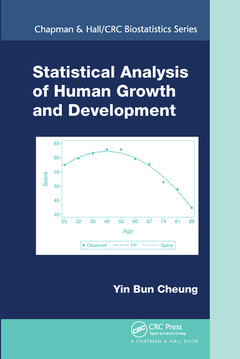Statistical Analysis of Human Growth and Development Chapman & Hall/CRC Biostatistics Series
Auteur : Cheung Yin Bun

Statistical Analysis of Human Growth and Development is an accessible and practical guide to a wide range of basic and advanced statistical methods that are useful for studying human growth and development. Designed for nonstatisticians and statisticians new to the analysis of growth and development data, the book collects methods scattered throughout the literature and explains how to use them to solve common research problems. It also discusses how well a method addresses a specific scientific question and how to interpret and present the analytic results. Stata is used to implement the analyses, with Stata codes and macros for generating example data sets, a detrended Q-Q plot, and weighted maximum likelihood estimation of binary items available on the book?s CRC Press web page.
After reviewing research designs and basic statistical tools, the author discusses the use of existing tools to transform raw data into analyzable variables and back-transform them to raw data. He covers regression analysis of quantitative, binary, and censored data as well as the analysis of repeated measurements and clustered data. He also describes the development of new growth references and developmental indices, the generation of key variables based on longitudinal data, and the processes to verify the validity and reliability of measurement tools. Looking at the larger picture of research practice, the book concludes with coverage of missing values, multiplicity problems, and multivariable regression.
Along with two simulated data sets, numerous examples from real experimental and observational studies illustrate the concepts and methods. Although the book focuses on examples of anthropometric measurements and changes in cognitive, social-emotional, locomotor, and other abilities, the ideas are applicable to many other physical and psychosocial phenomena, such as lung function and depressive symptoms.
Introduction. Causal Reasoning and Study Designs. Basic Statistical Concepts and Tools. Quantifying Growth and Development: Use of Existing Tools. Regression Analysis of Quantitative Outcomes. Regression Analysis of Binary Outcomes. Regression Analysis of Censored Outcomes. Analysis of Repeated Measurements and Clustered Data. Quantifying Growth: Development of New Tools. Quantifying Development: Development of New Tools. Quantifying Growth and Development: Longitudinal Measurements. Validity and Reliability. Missing Values and Imputation. Multiple Comparisons. Regression Analysis Strategy. References. Appendices. Index.
Yin Bun Cheung is a professor in the Centre for Quantitative Medicine, Office of Clinical Sciences at Duke-NUS Graduate Medical School in Singapore and adjunct professor in the Department of International Health at the University of Tampere in Finland. Dr. Cheung has been studying human growth and development in African and Asian countries for about 15 years.
Date de parution : 06-2020
15.6x23.4 cm
Date de parution : 10-2013
Ouvrage de 328 p.
15.6x23.4 cm
Thèmes de Statistical Analysis of Human Growth and Development :
Mots-clés :
Indonesia Family Life Survey; Root MSE; regression; LMS Parameter; coefficient; Pe Rc; quantile; Accelerated Failure Time Model; birth; Quantile Regression; weight; Head Circumference; GAMLSS; hypothesis; FP Model; stata; Ich Guideline E9; codes; FP; exposure; Gestational Duration; Multivariable Regression Analysis; Missing Values; Elementary Null Hypotheses; Global Null Hypothesis; Holm Adjusted; Cox Snell Residuals; Antenatal Care Package; Worm Plot; Generalized Gamma Model; Maternal HIV Status; Robust Variance Estimator; Mild Stunting; Rasch Model



